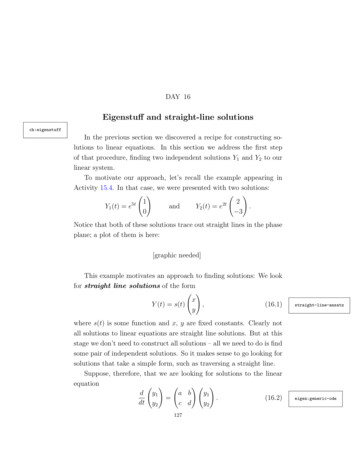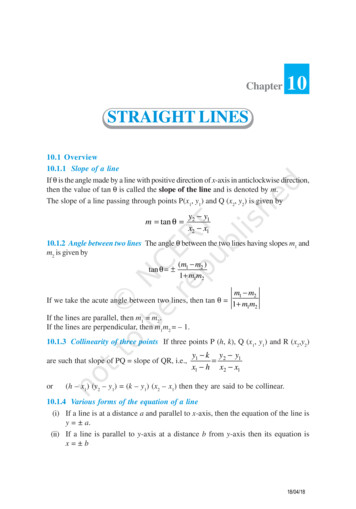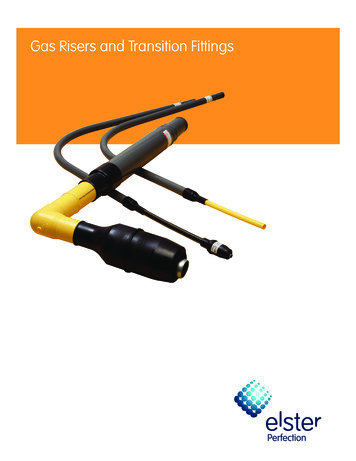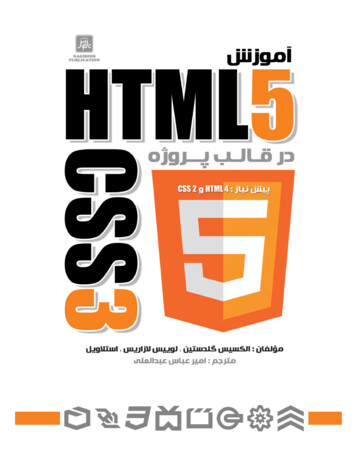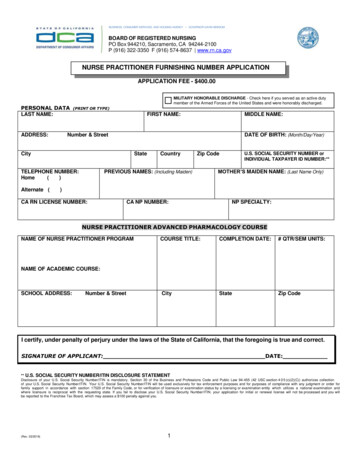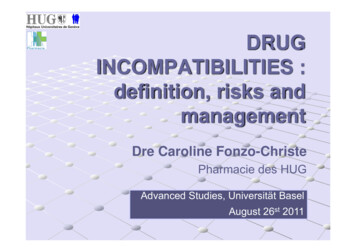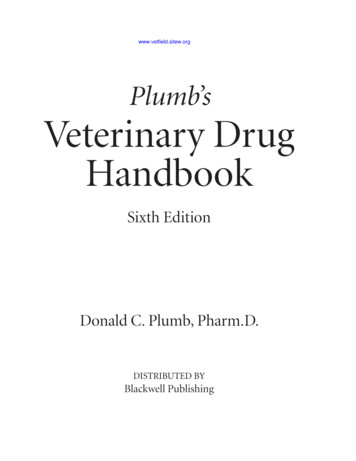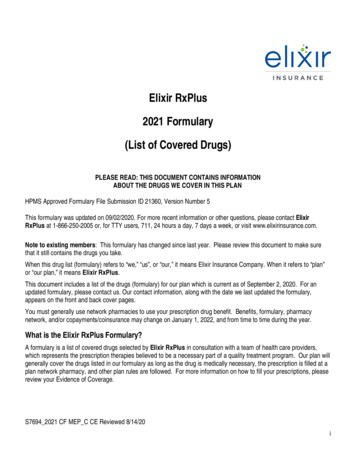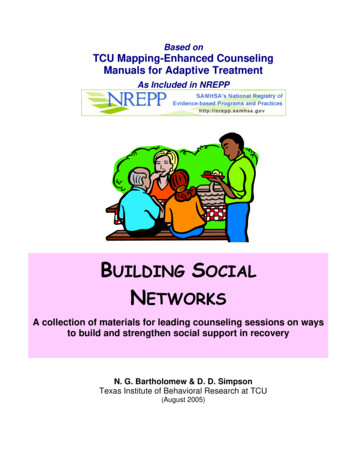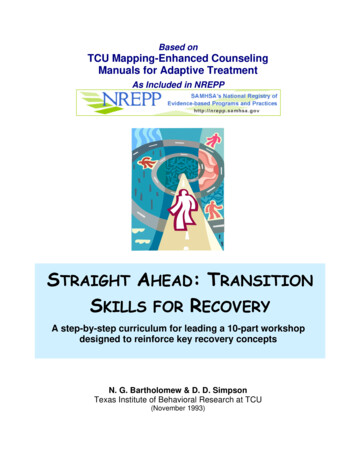
Transcription
Based onTCU Mapping-Enhanced CounselingManuals for Adaptive TreatmentAs Included in NREPPSTRAIGHT AHEAD: TRANSITIONSKILLS FOR RECOVERYA step-by-step curriculum for leading a 10-part workshopdesigned to reinforce key recovery conceptsN. G. Bartholomew & D. D. SimpsonTexas Institute of Behavioral Research at TCU(November 1993)
TCU Mapping-Enhanced Counseling manuals provide evidence-basedguides for adaptive treatment services (included in National Registryof Evidence-based Programs and Practices, NREPP, 2008). They arederived from cognitive-behavioral models designed particularly forcounselors and group facilitators working in substance abuse treatmentprograms. Although best suited for group work, the concepts andexercises can be directly adapted to individual settings.When accompanied by user-friendly information about clientassessments that measure risks, needs, and progress over time, TCUMapping-Enhanced Counseling manuals represent focused, time-limitedstrategies for engaging clients in discussions and activities onimportant recovery topics. These materials and related scientificreports are available as Adobe PDF files for free download athttp://www.ibr.tcu.edu. Copyright 2002 Texas Institute of Behavioral Research at TCU, FortWorth, Texas 76129. All rights reserved. Permission is hereby granted toreproduce and distribute copies of the manual, Approaches to HIV/AIDSEducation in Drug Treatment, (except reprinted passages from copyrightedsources) for nonprofit educational and nonprofit library purposes, providedthat copies are distributed at or below costs and that credit for authors,source, and copyright are included on each copy. No material may be copied,downloaded, stored in a retrieval system, or redistributed for anycommercial purpose without the expressed written permission of TexasChristian University.
iiThis manual was developed as part of NIDA Grant DA06162,Improving Drug Abuse Treatment for AIDS-Risk Reduction (DATAR).The Straight Ahead training module and all related data collectionforms may be used for personal, educational, research, and/orinformation purposes. Permission is hereby granted to reproduceand distribute copies of these materials (except reprinted passagesfrom copyrighted sources) for nonprofit educational and nonprofitlibrary purposes, provided that copies are distributed at or belowcosts and that credit for author, source, and copyright are includedon each copy. No material may be copied, downloaded, stored in aretrieval system, or redistributed for any commercial purpose without the express written permission of Texas Christian University.Institute of Behavioral ResearchTexas Christian UniversityTCU Box 298740Fort Worth, TX 76129(817) 257-7226(817) 257-7290 (FAX)Email: ibr@tcu.eduWeb site: http://www.ibr.tcu.eduCopyright 2002 Texas Christian University, Fort Worth, Texas.All rights reserved.Texas Christian University/DATAR Manual
iiiPrefaceAcknowledgmentsIntroduction — “Using This Manual”Special Notes and SymbolsSession TitleMaintaining Your RecoveryivviviixiPage1Social Networks and Recovery21Support Groups and Recovery41Family Recovery Issues: Support and Solutions55An Effective Communication Style75Skills for Better Relationships97Coping with Stress119Managing Anger in Relationships137Challenges for the Future155Graduation and Beyond175Appendix — Client Survey (pretest/posttest)ReferencesStraight Ahead: Transition Skills for Recovery185189
ivThe 10-weekStraight Aheadprogramprovides analternative fortreatmentThe TCU/DATAR project is concerned with enhancing drugabuse treatment and reducing client dropout and relapserates. A key area of investigation has involved cognitive enhancements to counseling through the use of node-link mapping in both group and individual counseling sessions. Inaddition, a variety of interventions have been developed for thisproject, including a structured AIDS/HIV information curriculum; treatment modules addressing relapse prevention, assertiveness training for women, and contingency management;and a social support and life skills package for clients who areapproaching readiness to leave treatment (Straight Ahead:Transition Skills for Recovery). Research for the DATARproject is being conducted by the Institute of Behavioral Research (IBR) at Texas Christian University, in collaborationwith three methadone treatment centers in Texas (CorpusChristi, Dallas, and Houston).agencies toprovide clientswith information, skills,and encouragement inways tostrengthen andmaintainrecovery ontheir own.Previous studies conducted by IBR have focused on long-termtreatment outcomes. The Drug Abuse Reporting Program(DARP) study examined 12-year outcomes for male opiateusers and looked at their reasons for starting, continuing, andstopping drug use, as well as the role of treatment in the recovery process. Among the many important findings in thisstudy was the validation of the “social” nature of addictioncareers. Those who maintained abstinence reported that theirefforts were helped by avoiding old drug-using friends andhangouts, developing new friends, interests and work habits,and reestablishing family ties and relationships (Simpson, Joe,Lehman, & Sells, 1986; Simpson & Sells, 1990). Treatmentwas seen as an important component for helping addictedpeople begin the social change process necessary for long-termrecovery. Other researchers who studied the process of recovery in nontreated individuals reported on the importance ofsocial change as well, especially in the areas of establishingsupportive, drug-free social networks and developing newnondrug-related interests (Waldorf & Biernacki, 1981; Waldorf,1983).Texas Christian University/DATAR Manual
vThe Straight Ahead training manual was developed as atraining and reference tool for substance abuse counselors inthe TCU/DATAR project to use with clients who have completed the “primary” phase of their treatment program. Thiswould include clients who have ceased or greatly reducedillegal drug use and alcohol use and have shown evidence ofstabilization in terms of program attendance, employment oreducational involvement, and desire for change. The focus ofthe manual is on helping clients develop social skills and support networks for recovery maintenance. The manual addresses relapse prevention, friends and social networks,12-step and other community-based self-help, family recoveryissues, assertive communication, stress reduction, anger management, and planning and problem-solving. These “transition” skills are seen as an important adjunct for preparing theclient to establish his or her own continuing aftercare supportsystem for recovery maintenance once involvement in primarytreatment has ended.Restricted staff time and budget constraints have reduced thenumber of formal aftercare programs available in public treatment settings. The 10-week Straight Ahead program provides an alternative for treatment agencies to provide clientswith information, skills, and encouragement in ways tostrengthen and maintain recovery on their own.Straight Ahead: Transition Skills for Recovery
viOur special thanks to Charlotte Pevoto for conceptualizing thelayout and design of this training manual. The hands-on,user-friendly quality of this manual is due to her skills andcreativity. Thanks also to Dr. Barry S. Brown for his review ofthe manual and excellent editorial suggestions, and to Drs.Don Dansereau and Sandra Dees for their guidance and suggestions for the structural map exercises in this manual.We also want to acknowledge the many contributions of thecounselors and supervisors of the Corpus Christi Drug AbuseCouncil (CCDAC) in Corpus Christi, Texas, and adVance Treatment Center, Inc., in Houston, Texas. Their help in fine-tuningand field testing this manual is very much appreciated.Texas Christian University/DATAR Manual
viiUsing This ManualThe Straight Ahead module consists of ten, two-hour sessions and is best suited for small groups of five to seven participants. The manual follows a “cookbook”/training guide approach with sequence, instructions, and approximate timesincluded for each exercise, activity, and discussion. Icons andmargin notes are used to draw attention to this information.Materials and preparation considerations are listed at thebeginning of each session. Information handouts and activityworksheets for copying are included at the end of each session,along with an evaluation for the session. A sample pretest/posttest instrument for the module (Straight Ahead ClientSurvey) is found in the Appendix.The sessions were designed to be presented sequentially, andour initial experiences indicate participants enjoy the pacing ofthe activities, exercises, and discussions. However, the “cookbook” approach also allows for flexibility. The material can beadapted to meet the demands of a variety of drug and alcoholtreatment programs. As with any cookbook, feel free to add,substitute, expand, or rearrange these materials to suit yourpreferences and the needs of your program. In some cases youmay find it helpful to extend the material suggested for onesession over two or more sessions. This allows you to adaptthe material for shorter meetings or for occasions when thegroup’s interest and receptivity warrants longer discussions.In short, the manual is a resource to use in the way that worksbest for you and your clients.The groups are intended for clients who have completed atleast their “first 90 days” of primary treatment, and who havebeen successful in quitting or dramatically reducing drug use.The module is best suited for those who are not in deep crisis,who seem to be making progress in recovery, and who havemade optimal use of individual and group counseling servicesand other opportunities for resolving their problems with sub-Straight Ahead: Transition Skills for Recovery
viiiIntroduction — “Using This Manual”stance use. Ideally, it can be used as an aftercare “readiness”package for helping clients frame and focus their goals forcontinued recovery and the steps needed to realize those goals.Psychoeducational groups which address recovery issues havebeen identified as important components of drug treatment,and especially useful in methadone maintenance programs (LaSalvia, 1993; Stark, 1989). The topics included in StraightAhead are those cited in the drug and alcohol treatment literature of the last fifteen years as relevant for recovering people.These include avoiding relapse (Marlatt & Gordon, 1985;Nurco, Stephenson, & Hanlon, 1991; Zakon, McAuliffe, &Ch’ien, 1985); improving social and family support (Gibson,Sorensen, Wermuth, & Bernal,1992; Goehl, Nunes, Quitkin, &Hilton, 1993; Kaufman, 1980); creating drug free social networks (Fraser & Hawkins, 1984; Hawkins, 1980); utilizingcommunity-based self-help groups (Brown & Ashery, 1979;Dupont, McGovern, & Brock,1992; Humphries, Mavis, &Stofflemayr, 1991; McCrady & Irvine, 1989; Zweben, 1987);and communication and life skills training (Callner & Ross,1978; Hawkins, Catalano, & Wells, 1986; Monti, Abrams,Binkoff et al, 1990). Straight Ahead groups serve to impartinformation and advice within these topic areas, as well as toencourage participants to invent, explore, and discover potential solutions to problems or concerns they may be experiencing.Weekly recovery discussionsAfter the first session, subsequent sessions begin with a halfhour period set aside for participants to discuss “homework”assignments and their successes and challenges during theweek. This time allows participants to “reconnect” with eachother informally before moving on to the more structured anddidactic part of the session. Participants are encouraged tokeep a Weekly Recovery Journal, a single page chart onwhich they can jot down successes, challenges, and goalsaround specific recovery issues.At the end of each session a specific assignment task, basedon the day’s topic, is suggested to participants (for example,“In the week ahead, practice using I-statements more frequent-Texas Christian University/DATAR Manual
ixly”). The assignments are then discussed the following week atthe beginning of the session, along with other issues participants have noted in their journals. These assignments are tobe suggested, but not mandated. Avoid leading into thesediscussions by asking “Did you do your homework?” Instead,use the lead-ins suggested in the manual to encourage participation in the discussion regardless of whether or not someonewas able to complete the assignment.Exercises and activitiesMany of the exercises and suggested discussion questions inStraight Ahead are designed to empower participants byencouraging them to think positively about their strengths,abilities, and resources for discovering solutions to the challenges and difficulties they face in recovery. This approachdraws on aspects of motivational interviewing as suggested byMiller and Rollnick (1991), as well as approaches developed byBrief Family Therapy practitioners (Berg & Miller, 1992; deShazer, 1985; Lipchik, 1988; Lipchick & de Shazer, 1986;O’Hanlon & Weiner-Davis, 1989).Some exercises and handouts use structured maps to helpparticipants focus on specific issues or information. Thesestructured maps are part of a system called node-link mapping,a cognitive enhancement approach developed by Dr. DonaldDansereau and colleagues at TCU and used extensively inseveral DATAR interventions (Dansereau, Joe, & Simpson,1993). A counselors’ manual on node-link mapping, MappingNew Roads to Recovery, is available through the DATARproject and is listed in the Reference Section of the manual.Here are some closing suggestions for working with theStraight Ahead materials:Review the Straight Ahead manual: Read through the manual and become familiar with the topics, approaches, andlayout of the materials.Choose your group members: Straight Ahead is designedfor clients who are not in crisis, and who are approachingreadiness for aftercare or “graduation” from a formal treatmentStraight Ahead: Transition Skills for Recovery
xIntroduction — “Using This Manual”setting. At minimum, some degree of success in beginning andmaintaining sobriety should be a prerequisite for inclusion.Where possible, remove barriers to attendance: Transportation, child care, and meeting times are factors that influenceattendance. Bus tokens or carpool coordination may be needed by some potential group members. On-site child care canhelp those with children (especially women) attend more easily.Offering groups during the early evening or on weekends mayappeal to working clients.This manual has been designed to provide chemical dependency counselors with a structured approach for helping clientsimprove their skills and develop strategies for positive change.It is hoped that practitioners will find this manual a useful tooland handy reference for helping people reach and maintaintheir recovery goals.Texas Christian University/DATAR Manual
xiIn addition to its convenient step-by-step approach, theStraight Ahead training manual is designed with specialnotes and symbols, or icons, to assist the group leader withhelpful hints and in organizing materials for sessionpreparation.NOTE!The term NOTE! in the narrow column informs you ofspecial information and tips in using this training manual.The following icons appear throughout the manual and indicate at what point objects and special procedures are used inthe pre-session preparation and presentation steps. Icons areplaced in the narrow column directly opposite correspondingtext or figures.Certificate for graduation/recognitionCopies of handouts, worksheets, or evaluationsCrayons, colored pencils, or markers for participant useDirectory list of community resources for session topicFlip chart materialsStraight Ahead: Transition Skills for RecoveryICONS
xiiSpecial Notes and SymbolsMarkers for preparing flip charts or listing points during discussion.Materials icon represents the list of items directly under the“Group Leader Materials and Preparation” in each sessionMusic — cassette tape or compact disc and the equipment toplay itPencils or pens for participant usePocket folders for participants to store handouts, etc.Refreshments for graduation sessionRole play procedure or materials10Time icon estimates the minutes needed to complete a procedure stepVideocassette tape and the equipment to present itTexas Christian University/DATAR Manual
1ObjectivesParticipants will:Understand the goals, rules, and content of the StraightAhead workshopExplore definitions of recoveryShare strategies for overcoming urges to useProcedureStepSegment NameTime1Welcome10 minutes2Overview of Straight Ahead:Goals, rules, structure10 minutes3Group introductions15 minutes4Open discussion: What is Recovery?20 minutes5Break10 minutes6Exercise: Write It on the Wall20 minutes7Discussion: Maintaining recovery15 minutes8Homework: Introduction toWeekly Recovery Journal10 minutes9Closure and evaluation10 minutesSession LengthStraight Ahead: Transition Skills for Recovery2 hours(120 minutes)SessionStructure
2Maintaining Your RecoveryGroup LeaderMaterials andPreparation Materials:Flip chart, newsprint, or chalkboardEasel markers or chalkPaper and pencils for participantsCrayons, colored pencils, or markers in assorted colorsPocket folders — one for each participant Prepare before class:GROUP GUIDELINESUse a sheet of flip chartpaper to write out theguidelines as shown:(Guidelines discussedon pp. 5-6.)GROUP GUIDELINESWhat is said here, stays here.Show respect -- for each otherand ourselves.Participate -- be involved.Share with others what hasworked for you.MOVING STRAIGHT AHEADUse a sheet of flip chart paperto write out the key points onthe Moving Straight Aheadhandout as shown:(Handout shown on p. 17.)MOVING STRAIGHT AHEADStop using all drugs.Avoid people and situationsthat trigger urges!Get support (a “partner” inrecovery).Form a self-image of yourselfas a recovering person.Plan your time and stay busy.Keep coming to this group.Texas Christian University/DATAR Manual
3 Prepare before class (continued):WRITE IT ON THE WALLLabel four sheets of flip chart paper as shown below:(Exercise discussion begins on p. 9.)(2)(1)Thoughts or feelingsthat trigger urges to usePeople or situations thattrigger urges to use(3)How do you overcomecravings? What works?(4)What do you like mostabout yourself when youdon’t use?ICONSIconsappearin thisnarrow columnof the page todraw yourattention towhere materials, preparations, andhandouts areused in thesessions.All icons aredescribed inthe section,“Special Notesand Symbols,”pp. xi-xii. Make copies:What is Recovery? handout (p. 16)Moving Straight Ahead handout (p. 17)Weekly Recovery Journal (p. 18)Session One Evaluation (pp. 19-20)Client Survey/pretest (optional — pp. 185-187)Straight Ahead: Transition Skills for Recovery
4Maintaining Your RecoveryProcedureSteps10Welcome Welcome participants as they arrive. Administer the Client Survey/pretest (optional). Introduce yourself by giving your name. Go around theroom and ask participants to do the same. If you are ableto provide transportation assistance or child care during theStraight Ahead sessions, go over the details. Let participantsknow there will be a short break about halfway through eachmeeting. Distribute pocket folders, and ask participants to usethem to store their handouts and materials. Suggest theybring their folders to each session.10Overview: Goals, rules, and structure Discuss the goals and purpose of the Straight Aheadworkshops, using information from the following script:SCRIPT:Goals andPurpose of theStraightAheadWorkshopsThe purpose of the Straight Ahead workshops is tohelp you make a commitment to long-term recovery.This is sometimes called the maintenance stage ofrecovery. Maintaining your recovery is likely to be oneof the most difficult accomplishments of your life —and also one of the most rewarding. Each of you is tobe commended for the strength and courage that hasbrought you to your present level of recovery.Texas Christian University/DATAR Manual
5Straight Ahead is designed to help you expand yourskills, confidence, and sources of support as you continue to work on maintaining recovery. The goal ofStraight Ahead is to help you build a strong foundation for recovery. This includes improving relationships with family and friends, taking advantage ofcommunity recovery groups, setting goals, and makinga life for yourself beyond the drug scene. Some of theissues we’ll address include:Getting along better with peopleDealing with stress, anger, and conflictMaintaining a positive self-conceptImproving family relationshipsMaking plans and solving problemsDealing with cravings and triggersTaking credit for your successesGetting involved in the recovering communityThese are areas of daily living where all of us can usesome help — so the philosophy of the group will be tohelp each other. We will share our experiences, offersupport and understanding, and learn from eachother.In order to do this effectively, let’s consider a fewguidelines for how the groups will operate. Introduce the Group Guidelines. Use the flip chart outline of the main points as shown on page 2 to lead the discussion. What is said here, stays here.We all need a safe place to talk about our feelings,concerns, and progress in recovery. Therefore, we willhonor each person’s confidentiality.Straight Ahead: Transition Skills for RecoveryIssuesaddressed byStraightAhead
6Maintaining Your Recovery Show respect — for each other and ourselves.This would include listening to each other; not engagingin put-downs, threats, or hostility; and being supportiveof each other. Participate — be involved.Listen; contribute; share your thoughts and experiences;take part in the exercises and take home assignments. Share with others what has worked for you.To help strengthen recovery it’s important to stay focusedon what works. If it works, do more of it. This group is aplace to talk and share with others what you’ve found tobe successful.After briefly discussing each guideline and the reasons for it,ask group members if they would like to add any additional guidelines. If there is a consensus for an additionalguideline, add it to the list. When the list is complete, secureclosure by asking the group for an indication of approval (suchas a show of hands or an informal voice vote). You may chooseto bring the Group Guidelines list to future meetings for reference. Invite general questions from participants about thegoals or guidelines for the group.Texas Christian University/DATAR Manual
715Group introductions After answering any questions about the StraightAhead topics or program goals, go around the room andask participants to introduce themselves. Give each personabout 2-3 minutes. Write the following questions on flip chartor chalkboard, and ask each person to answer them by way oftheir introduction: Your name (or the name you like to use)How long in the program?Who’s “special” in your life?What is one thing you do really well?Where do you want to be in your recovery six monthsfrom now? Introduce yourself by answering the same questions asthe participants. Skip the last question if it doesn’t apply toyou.Open discussion: What is Recovery? Introduce the topic of recovery by reminding participantsthat one goal of Straight Ahead is to improve skills for maintaining recovery, and to help them take advantage of thesources of support available from their families, friends, andthe community. Write “recovery from drug addiction” on flip chart orchalkboard and ask participants to help you brainstorm alist of meanings for the phrase. Prompt as needed. Forexample: “When we say someone has recovered from addiction,what do we mean? What all is involved?” List responses. Sug-Straight Ahead: Transition Skills for Recovery20
8Maintaining Your Recoverygest and add items, as needed, to assure that the followingideas are included:What isRecovery?DiscussionPoints Not using — no matter what!Change attitudes about drugs and drug users.Spend more time with people who don’t use.Get involved: job, school, hobby, pastime.Find a drug free support network.Resolve anger, guilt, frustration about past drug use.Do what works to help you avoid cravings.Find new, enjoyable social activities without drugs.Ask for support when you need it.Learn new skills and be open to new ideas. Distribute handout What is Recovery? for participantsto review. Summarize using information from the following script.Allow further discussion and comment as needed.SCRIPT:SummarizingWhat isRecovery?There is more to recovery than quitting drug use.However, you cannot begin to work on recovery untilyou have quit using. Abstinence or cessation of druguse is the foundation of recovery, and for many peopleit’s the easiest step. Staying quit is much more difficult. Staying quit involves making changes in yourattitudes, in your family and social relationships, andin your responses to feelings and life events. Thesechanges are the ones that give you the strength andthe skills to maintain your recovery. And maintainingrecovery is the key.As you move ahead in recovery, it’s important totell family members and friends about your needsas you make changes. Often, family members andfriends believe that once the recovering person hasquit using, then he or she is “fixed.” Talk with yourTexas Christian University/DATAR Manual
9family and friends who support your recovery effortsand help them understand about the complexity ofrecovery. Al-Anon or Families Anonymous groups maybe especially helpful for those needing support andeducation about recovery issues. You’ll also benefitfrom setting limits (“drawing the line”) with family andfriends who don’t support your recovery or who continue to use drugs themselves.Ultimately, you’re responsible for your own recovery — no one else. Help, support, and advice are allimportant, but you’re the one who puts the wheels inmotion. Give yourself credit for each tiny step youtake in the right direction. You’re responsible for yoursuccesses and for continuing to figure out what willwork best to help you maintain recovery.10Break Allow a 10 minute break.Exercise: Write It on the Wall During the break, prepare for the Write It on the Wallexercise by hanging the four sheets of flip chart paper ornewsprint around the room which have been labeled asshown on page 3. Welcome the group back from break, and explain that theremainder of the session will focus on a key issue in recovery:What works for overcoming urges to use?Straight Ahead: Transition Skills for Recovery20
10Maintaining Your Recovery Distribute crayons, markers, or colored pencils for theWrite It on the Wall exercise. Tell participants that theexercise is designed to open up discussion about what leads tocravings and what works to beat cravings. Read each of the posted topics aloud. Instruct participants to walk around and “write on the walls,” using theirmarkers to answer the questions or write about their experiences. Let them know they can write more than oneitem on each sheet. Explain that the only rule is their answers must be based on honest personal experiences, thoughtsand feelings. Encourage them to read what others have written as they move from sheet to sheet. Let them know they canbegin at any sheet, and move around the room in the orderthey prefer. Allow about 5-10 minutes for the exercise. Encourage people to go back around and read new items as theyare added to the lists.Processing theexercisePoint #1DiscussionQuestions Process the exercise by discussing the material generated on each of the sheets. Use some of the following questions to process each point. Use flip chart or chalkboard to listand consolidate answers: People or situations that trigger your urges to useWhat’s the best way to deal with people who triggerurges to use? What’s worked in your life?Think about people who help you not to use — what’sdifferent about them? How can you spend more timewith them?What works to get out of situations that trigger urges?What situations help you not to use?Texas Christian University/DATAR Manual
11 Thoughts and feelings that trigger your urgesto useWhat do thoughts about using “sound” like?Point #2DiscussionQuestionsWhat’s been successful for you in “talking back” tothose thoughts?What feelings or emotions make you vulnerable tousing?What has worked for you in handling difficult feelings? How do you overcome cravings? What works?How did you figure out what works for you to overcome cravings?Point #3DiscussionQuestionsHow do you reward yourself when you’re able to dealwith cravings? What do you like most about yourself when youdon’t use?What do your family/friends notice that’s differentabout you when you’re not using?What do you do differently when you’re not using?Straight Ahead: Transition Skills for RecoveryPoint #4DiscussionQuestions
12Maintaining Your Recovery Summarize the exercise by discussing the key pointsfrom the following script:SCRIPT:Summarizing theWrite It on theWall exerciseMost people in recovery have a sort of “early warningsystem” that can alert them when the risk for “slipping” or using is high. Learning to listen for this“warning” system takes practice because the cues areoften very subtle.Your early warning system may be sounding if younotice one or more of the following changes: Changes in thoughts or attitudes about recovery— For example, not caring about recovery efforts;thinking that drugs are deserved because you'vebeen so “good” lately; or thinking you can controlyour use. Changes in feelings — For example, noticing greater than usual feelings of depression, anger, anxiety,guilt, or frustration. Changes in how you act — For example, fightingor arguing a lot; finding excuses to visit places orpeople associated with drugs; not attending groupor couns
Straight Ahead: Transition Skills for Recovery Using This Manual The Straight Ahead module consists of ten, two-hour ses-sions and is best suited for small groups of five to seven partic-ipants. The manual follows a “cookbook”/training guide ap-

